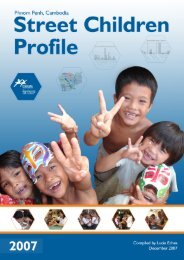Download - Friends International
Download - Friends International
Download - Friends International
You also want an ePaper? Increase the reach of your titles
YUMPU automatically turns print PDFs into web optimized ePapers that Google loves.
the number of street children/youth who qualify for being counted is higher than if the<br />
conventional definition of street children is applied. This is, however, a reflection of the<br />
CSCNs ambition to push for a general revision of the definition, as many NGOs working<br />
with street children end their activities when the children turn 18 years of age - even<br />
when further support is needed.<br />
Finally, inconsistent usage of the street children definition between NGOs and others<br />
working with the topic has an impact on understanding the various dimensions of<br />
problems relating to street children, and in consequence their exact magnitude. As the<br />
SCP 2009 primarily is com-piled for internal usage and the method applied each year<br />
is consistent, there is no methodo-logical hindrance to comparing the data from the<br />
different years.<br />
Data Collection Methods<br />
To facilitate the collection of data about street children/youth in six Cambodian<br />
locations, this study is comprised of three main analytical frames, each based on a<br />
specific methodological approach. Frame I seeks to provide a general overview of<br />
issues and official statistics relevant to support the analysis of the data derived from<br />
Frame II and Frame III, assembling a snapshot survey and a questionnaire respectively.<br />
By combining three different methodologies and the application of both primary and<br />
secondary data to the analysis, it has been possible to generate information about the<br />
street children/youth with reasonable accuracy.<br />
The six locations where the two different surveys were carried out - Phnom Penh, Siem<br />
Reap, Neak Loeung, Sihanoukville, Kampong Cham and Poipet – were selected on<br />
the basis of the size of the street children population or areas involving explicit risks to<br />
the children. Moreover, the locations represent areas that are either highly populated,<br />
attract tourism or are migration hubs such as the Thai and Vietnamese borders. A final<br />
criterion for selecting the locations is directed by where the CSCN members operate,<br />
so as to provide a specific knowledge of the street children/youth populations of each<br />
site. What follows is a brief description of each location, though a more elaborated<br />
CSCN<br />
CSCN Street Children Profile 2009<br />
11






